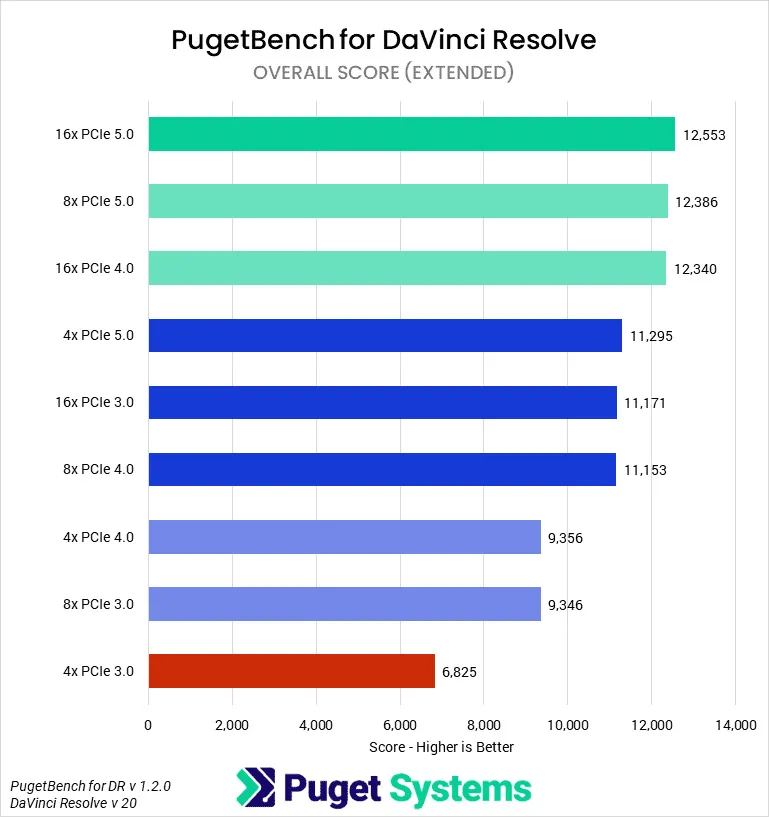NVIDIA RTX 5090 Performance Drops 25% When Starved of PCIe Bandwidth
NVIDIA's flagship GeForce RTX 5090 graphics card can lose up to 25% of its performance in video editing and 3D rendering tasks when constrained by insufficient PCIe bandwidth, according to comprehensive testing by Puget Systems. The findings reveal a critical bottleneck that could significantly impact professionals and content creators who don't have access to the latest motherboard technology.
The RTX 5090 represents a significant leap in interface technology, becoming the first high-end consumer graphics card to adopt PCIe 5.0 x16 connectivity. This advancement delivers 64 GB/s of bidirectional bandwidth—exactly double the 32 GB/s available to the previous-generation RTX 4090 running on PCIe 4.0 x16. However, the increased bandwidth requirements mean the card becomes more sensitive to interface limitations than its predecessors.
Puget Systems conducted extensive benchmarking across multiple content creation applications to quantify the real-world impact of PCIe constraints. The testing compared various PCIe generations and lane configurations, from the latest PCIe 5.0 x16 down to older PCIe 3.0 x8 setups that might be found in legacy systems or configurations where lanes are shared with storage devices.

The results varied significantly depending on the application and workload type. In DaVinci Resolve, one of the most demanding video editing platforms, the RTX 5090 maintained consistent performance across PCIe 5.0 x16, PCIe 5.0 x8, and PCIe 4.0 x16 configurations. However, performance began to degrade when bandwidth dropped to around 16 GB/s, with PCIe 5.0 x4, PCIe 4.0 x8, and PCIe 3.0 x16 configurations showing approximately 10% longer render times.
The most dramatic performance impact occurred when bandwidth fell below 8 GB/s. Configurations running PCIe 4.0 x4 or PCIe 3.0 x8 resulted in render times that were roughly 25% longer than optimal setups. This represents a substantial productivity loss for professional workflows where time directly translates to revenue.
Adobe After Effects proved more resilient to bandwidth constraints, showing only minor performance degradation until bandwidth dropped well below 8 GB/s. Meanwhile, Unreal Engine 5.5 virtual production workloads experienced about a 7% reduction in average frame rates at the lowest lane configurations tested.
Not All Workloads Are Equally Affected
Interestingly, some applications showed little to no sensitivity to PCIe bandwidth limitations. Blender offline rendering and OctaneBench scores remained essentially unchanged across all tested configurations, suggesting these workloads rely more heavily on the GPU's internal memory and compute capabilities rather than constant data transfer with system memory.
Large language model benchmarks using Llama showed no measurable dependency on PCIe speed, indicating that AI inference workloads may not benefit from the RTX 5090's enhanced interface capabilities in the same way that video editing and real-time rendering applications do.
The RTX 5090's PCIe 5.0 implementation uses the same NRZ signaling technology as PCIe 4.0 but incorporates enhanced signal integrity measures, including decision feedback equalization and tighter timing controls. While the card maintains full backward compatibility with older PCIe standards, the testing reveals that this compatibility comes with significant performance trade-offs for bandwidth-intensive applications.
The findings highlight a common limitation in modern PC configurations: most motherboards reserve full x16 lanes for only one PCIe slot, forcing additional graphics cards, storage devices, or expansion cards to operate at reduced speeds. This means a flagship GPU like the RTX 5090 could unknowingly operate at PCIe 4.0 x4 speeds if users aren't careful about their system configuration, potentially extending project turnaround times for professionals working with high-resolution video or complex 3D scenes.
For content creators and studios planning to invest in RTX 5090 hardware, the research provides clear guidance: verify that the graphics card will operate in a full-bandwidth PCIe slot to achieve optimal performance. This consideration becomes even more critical for multi-GPU configurations, where lane allocation becomes increasingly complex and performance losses could compound across multiple cards.
